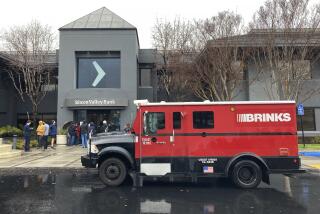S&L; Bailout Bill May Need Another $50 Billion
- Share via
WASHINGTON — The savings and loan industry bailout bill moving through Congress is likely to cost $20 billion to $50 billion more than the Bush Administration plans to spend to help clean up the most expensive financial disaster in U.S. history, experts say.
The Bush plan provides $50 billion initially to dispose of all the S&Ls; that now are insolvent and more that are expected to fail in the next three years.
However, experts on Capitol Hill and in the banking industry say that the Administration’s idea is too optimistic. They predict that more S&Ls; will fail than expected, that the losses will be bigger than the Administration predicted and that the economy will not be as healthy as the plan projects.
If the projections prove accurate, within a year or two Congress will have to hand taxpayers a second multibillion-dollar tab for the S&L; bailout. With the cost of the S&L; collapse estimated at $1,000 per taxpayer, the threat of an all-but-instant replay is widely viewed as a potential political disaster that could blow up just in time for the 1992 presidential campaign.
“The Administration made a terrible political miscalculation by low-balling the numbers,” said Robert Litan, an economist at the Brookings Institution.
“My belief is that it’s going to be significantly above $50 billion,” said Lowell Bryan, a director of McKinsey & Co., which has done several S&L; cost studies. In January, Bryan told the Senate Banking Committee that $100 billion would be needed to cover the present losses. He now calls that figure “an absolute minimum.”
The total cost of the S&L; industry collapse is now estimated by the Administration at $157 billion: $40 billion spent last year on the first 200 failures, $50 billion being spent now to clean up about 500 more, $24 billion for losses through 1999 and $43 billion in interest.
Because the $50 billion will be raised by selling 30-year bonds, the interest ultimately could reach $138 billion and put the total cost at more than $300 billion, House Banking Committee Chairman Henry B. Gonzalez (D-Tex.) said.
The money to pay for the S&L; clean-up is supposed to come from several sources besides taxes: raising the deposit insurance premiums paid by S&Ls;, tapping a share of the profits that the Federal Home Loan Bank System makes on its loans and selling the assets of the failed The U.S. League of Savings Institutions, which has long been accused of understating the industry’s difficulties, says the assumption that $50 billion will take care of problems for the next three years is based on assumptions that are “wildly optimistic,” according to Philip Gasteyer, executive vice president of the league, which is the largest trade association in the savings industry.
A high-level Treasury Department official said many of the complaints are coming from people who want to water down reforms in the bill by arguing that it will cost too much to limit risky S&L; financial practices. The greatest pressure on costs, the official said, is coming from special-interest provisions tacked on to the bill in the House and Senate.
More to Read
Get the L.A. Times Politics newsletter
Deeply reported insights into legislation, politics and policy from Sacramento, Washington and beyond. In your inbox twice per week.
You may occasionally receive promotional content from the Los Angeles Times.










